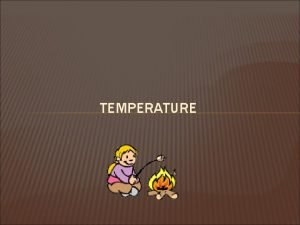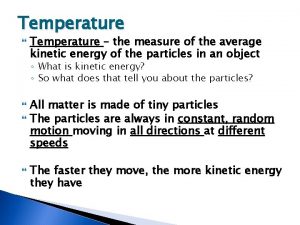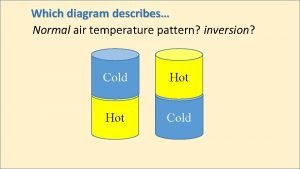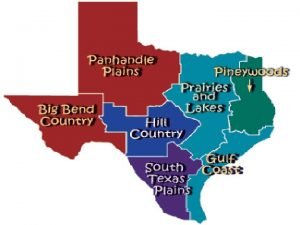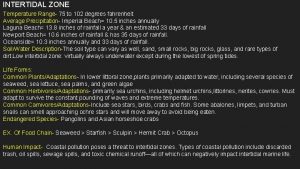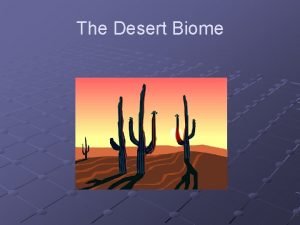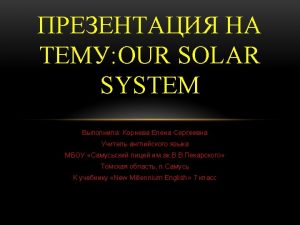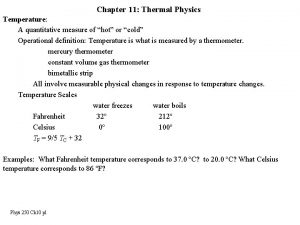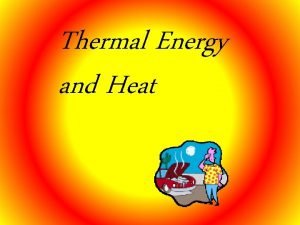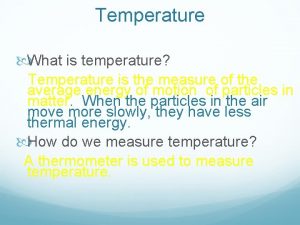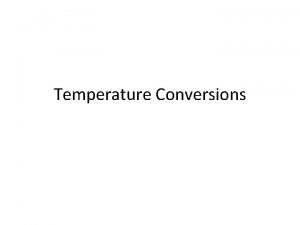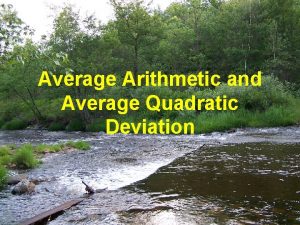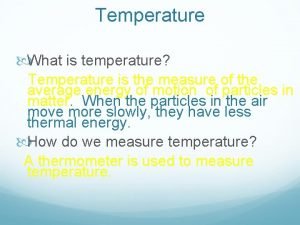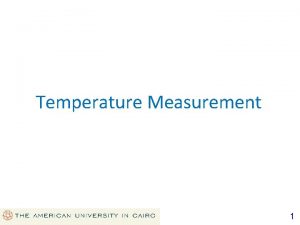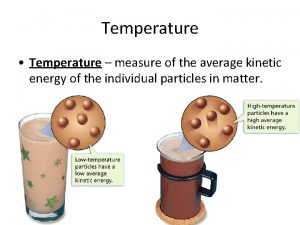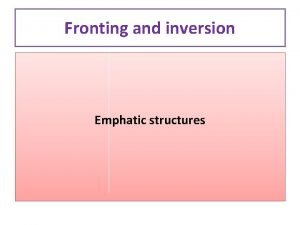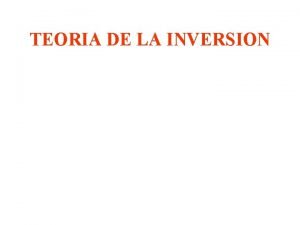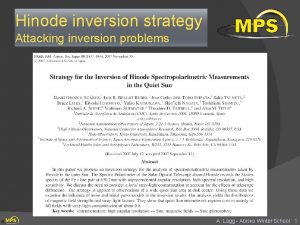Inversion Temperature Temperature a measure of the average




















- Slides: 20

Inversion Temperature

ØTemperature : a measure of the average speed at which molecules are moving or vibrating. ►Air temperature the rate of motion of gas molecules in the atmosphere as a result of the absorption of energy

WHAT IS TEMPERATUE ØAs we know that in the lower part of the atmosphere temperature generally decreases with increasing height. the atmosphere the density of air molecules decrease unlike near the earth surface where the air is held by the gravity resulting in high concentration of air and hence high pressure, the molecules collide among themselves generating heat (high temperature). As the density decreases so does the quantity of the air molecules which means huge gap between the molecules allowing them to move freely without colliding much with each other resulting in generation of less heat (low temperature). Temperature decreases as elevation increases. less mass, less pressure, less absorption

What do you understand by phenomenon of “temperature inversion” in meteorology? How does it affect weather? Temperature inversion, is a reversal of the normal behavior of temperature in the troposphere, in which a layer of cool air at the surface is overlain by a layer of warmer air. (Under normal conditions, temperature usually decreases with height). the temperature instead of decreasing starts increasing with altitude. This phenomena is known as negative lapse rate or Inversion of Temperature. v Effects ► Inversions play an important role in determining cloud forms, precipitation, and visibility. ► An inversion acts as a cap on the upward movement of air from the layers below. As a result, convection produced by the heating of air from below is limited to levels below the inversion. Diffusion of dust, smoke, and other air pollutants is likewise limited. ► In regions where a pronounced low level inversion is present, convective clouds cannot grow high enough to produce showers. ► Visibility may be greatly reduced below the inversion due to the accumulation of dust and smoke particles. Because air near the base of an inversion tends to be cool, fog is frequently present there.




surface inversion: Ø surface inversion also called as radiation inversion occurs near the earth’s surface due to radiation mechanism. This is also called as non advectional. A surface inversion develops when air is cooled by contact with a colder surface until it becomes cooler than the overlying atmosphere; this occurs most often on clear nights, when the surface cools off rapidly by radiation. If the temperature of surface air drops below its dew point, fog may result. Ø This kind of temperature inversion is very common in the higher latitudes. Ø Surface temperature inversion in lower and middle latitudes occurs during cold nights and gets destroyed during daytime. Ø Inversion near the surface is of very short duration because the solar radiation heats the surface during day time, . Upper air inversion lasts for longer duration because the warming of cold air layer aloft through terrestrial radiation takes respectively longer period of time. Surface

The ground surface inversion occurs under the following conditions: ► Air Long Winter Nights Loss of heat by terrestrial radiation is more than the insolation received during daytime as the nights are colder and longer. ► Dry Air Absorbs less heat radiated by the surface in comparison to moist air. ► Clear Sky More loss of heat without any obstruction after sunset as clouds absorb and delay the loss of heat. ► Calm air No or little mixing of air and hence less transfer of heat Ground gets suffice amount of time to cool down (Calm and stable air, so that there is no vertical mixing at lower levels). ► Snowy surface Albedo of snow is very high, the snow covered surface heats up slowly. At night, snow being a bad conductor of heat retards the flow of heat from ground underneath to surface air.


Advectional Inversion: Advectional inversion of temperature is also called as dynamic inversion because it is always caused due to either horizontal or vertical movements of air. Inversion occurs when warm air passes over cooler surface. This type is further divided into three types on the basis of the nature of air move ments e. g. : (i) Frontal or cyclonic inversion, (ii) Valley inversion due to vertical movement of air. (iii) Surface inversion due to horizontal movement of air.

UPPER AIR INVERSION This temperature inversion is called upper surface temperature inversion because it takes place in the upper parts of the atmosphere. Its of two types Ø Thermal upper air inversion which is caused by presence of ozone layer in stratosphere. It absorbs most of the UV rays radiated from the sun increasing the temperature of the layer much higher than the layers below and above it. This occurs only when there is no vertical movement of air only ascent and descent of air. Ø Mechanical inversion is caused due to subsidence of air and Turbulence & Convection mechanism.

SUBSIDENCE INVERSION This type of upper air inversion occurs in an air mass when a thick mass of air subsides due to high pressure cell. The sinking air compresses and warms at the dry adiabatic rate of 10°C/km. In certain cases, the subsidence continues to a particular level where the air diverges horizontally above a lower layer of colder air. Occurs commonly in regions of high pressure.

TURBULENCE & CONVECTION INVERSION ► Convectional currents in the air near the ground are mainly responsible for the exchange of air between upper and lower levels of the atmosphere. The phenomena of turbulence and convection cause a thorough mixing of the atmosphere in turbulent layers. ► In the process of vertical mixing (convection) the air carried upward is cooled adiabatically. Similarly the air brought downwards heated at the same adiabatic rate. The ; of warm and cool air produces frictional eddies which causes instability or turbulence. ► After a prolonged mixing in the atmosphere, the air at the maximum height of turbulent penetration becomes colder than what it was before, and that at the bottom of the turbulence layer will be warmer than what it originally was. ► In certain situations, turbulence in association with heat from the ground leads to the formation of cumulus or cumulonimbus clouds. ► Turbulence inversion may occur at a low level or it may form at very high altitudes. In case the inversion has formed at lower levels, smoke, dust particles and other pollutants are carried up to the inversion where they spread beneath the inversion layer and form distinct smoke or haze lines in clear weather.


FRONTAL INVERSION ► Occurs when differing air masses converge. ► The warmer air being relatively higher tends to overlie the colder and denser air in a horizontal layer but however due to the coriolis force the boundary zone between these contrasting air masses is sloping. ► The frontal zone itself is converted into inversion layer in which the lapse rate is inverted.

Some of the most significant consequences of temperature inversions are the extreme weather conditions they can sometimes create. ► Freezing rain- This phenomenon develops with a temperature inversion in a cold area because snow melts as it moves through the warm inversion layer. The precipitation then continues to fall and passes through the cold layer of air near the ground it becomes cooled below freezing without becoming solid. The super- cooled drops then become ice when they land on items like cars and trees and the result is freezing rain or an ice storm. ► Intense thunderstorms and tornadoes are also associated with inversions because of the intense energy that is released after an inversion blocks an area’s normal convection patterns. ► Smog- This is the brownish grey haze that covers many of the world’s largest cities and is a result of dust, auto exhaust, and industrial manufacturing. This happens because the warmer air layer accumulates over an area and prevents the normal mixing of cooler, denser air. The air instead becomes still and over time the lack of mixing causes pollutants to become trapped under the inversion, developing significant amounts of smog. During inversions that last over long periods smog can cause respiratory problems for the inhabitants of those areas

Boundary Layer Depth Variability in different pressure system : Near a region of high pressure: Over both land oceans, the boundary layer tends to be shallower near the center of high pressure regions. This is due to the associated subsidence and divergence. few clouds form in this region, boundary layer depth increases on the periphery of the high where the subsidence is weaker. clouds are more apt to form in this region Near a region of low pressure: the rising motion associated with the low transports boundary layer air up into the free troposphere. Hence, it is often difficult to find the top of the boundary layer in this region. In a situation such as this where the boundary layer is not evident in a sounding, cloud base is often used at the top of the boundary layer. this may be somewhat arbitrary, but it is objective and makes some physical sense.

► Why Study ABL? Humans live in the ABL. Fluxes are mediated here. 50% of the atmosphere’s kinetic energy is dissipated in the boundary layer. It is the location of the source and sink of many trace gases (including water vapor, CO 2, ozone, methane) and dusts/pollutants. It is a reservoir of trace gases and pollutants. It is important for local forecasting. There is a strong effect on the rest of the atmosphere. Boundary-layer clouds are very important for climate. ► Planetary Boundary Layer (PBL) Top of the atmospheric boundary layer can be defined as the lowest level in the atmosphere at which the ground surface no longer influences the meteorological parameters through turbulence transfer of mass During day this corresponds to Mixing height (up to 3 km in height)Processes include : Roughness of terrain Obstructed flow Heat and energy transfer PBL is that layer of air (up to 3 km in height) which is influenced by friction from the earth's surface and the processes that occur there such as: roughness of terrain, obstructed flow, and heat and energy transfer.

► what happens when no heat is added or extracted to a parcel of air? When a parcel of air, either dry or containing water vapor, rises or sinks without the addition or extraction of heat, that process is said to be a dry adiabatic process. ► Stability in the Boundary Layer States –Unstable, usually daytime, caused by swirling eddies rising off the heated surface because they are more buoyant than surrounding air –Stable, usually at night, only mean wind and waves, little turbulence causes only horizontal transport –Neutral, upper BL at night, turbulence at equal intensity in all directions
 Temperature is a measure of the average
Temperature is a measure of the average Temperature is a measure of average
Temperature is a measure of average Measure of average kinetic energy
Measure of average kinetic energy What does a wind vane measure
What does a wind vane measure Tempersture inversion
Tempersture inversion Straight line motion
Straight line motion What is the average quantile measure
What is the average quantile measure Gibbons jacobean city comedy download
Gibbons jacobean city comedy download Pineywoods characteristics
Pineywoods characteristics Taiga average precipitation
Taiga average precipitation Intertidal zone temperature
Intertidal zone temperature Desert biome climate
Desert biome climate Diameter of mercury in km
Diameter of mercury in km Clifden ireland average temperature
Clifden ireland average temperature Where is the temperate forest located
Where is the temperate forest located Climate of rainforest biome
Climate of rainforest biome Is temperature a quantitative measure of heat
Is temperature a quantitative measure of heat Thermal energy vs temperature
Thermal energy vs temperature Temperature is a measure of *
Temperature is a measure of * Ferromagnetis
Ferromagnetis Difference between curie temperature and neel temperature
Difference between curie temperature and neel temperature

